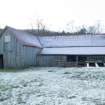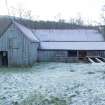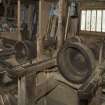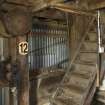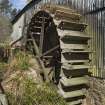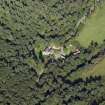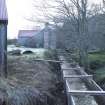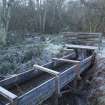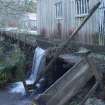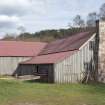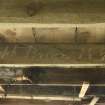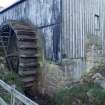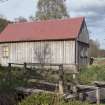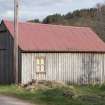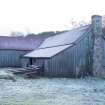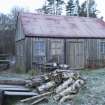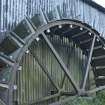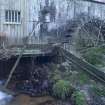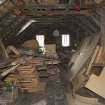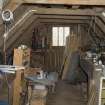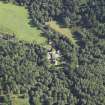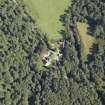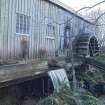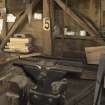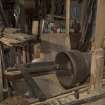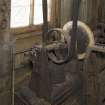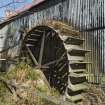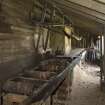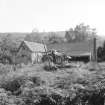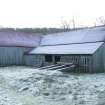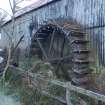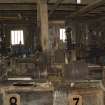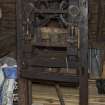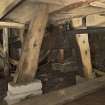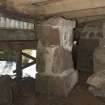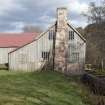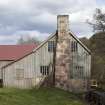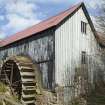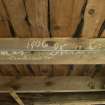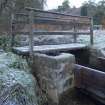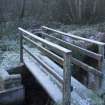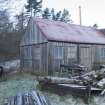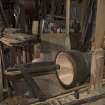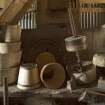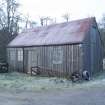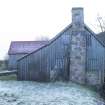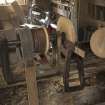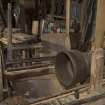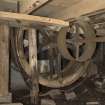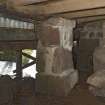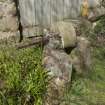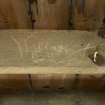Finzean, Bucket Mill
Saw Mill (19th Century), Watermill (19th Century), Wood Processing Site, Wood Turning Workshop
Site Name Finzean, Bucket Mill
Classification Saw Mill (19th Century), Watermill (19th Century), Wood Processing Site, Wood Turning Workshop
Alternative Name(s) Woodend; Water Of Feugh
Canmore ID 35320
Site Number NO59SE 9
NGR NO 57760 91208
Datum OSGB36 - NGR
Permalink http://canmore.org.uk/site/35320
- Council Aberdeenshire
- Parish Birse
- Former Region Grampian
- Former District Kincardine And Deeside
- Former County Aberdeenshire
NO59SE 9.00 57760 91208
NO59SE 22 59119 91586 Finzean Sawmill and Turning Mill
NO69SW 19.01 61170 92012 Mill of Clinter
(Location cited [incorrectly] as NO 582 9130). Birse, Bucket Mill: Built 1853. A 1-storey and attic, wood and rubble building, with a corrugated-iron roof. There is a mid-breast paddlewheel about 12ft (3.66m) diameter. A decayed part of the wooden lade has been replaced by 10 plastic hosepipes. Now disused.
J R Hume 1977.
Descheduled.
Information from Historic Scotland, document dated 28 February 1997.
NO59SE 9.00 57760 91208
NO59SE 9.01 57756 91202 Lade and Sluice Gate
NO59SE 9.02 57585 81162 Weir and Sluice Gate
NO59SE 9.03 57731 91218 Stable and Cart House
Single storey and attic, 3-bay, L-plan Bucket Mill with Sawmill adjoining. The Finzean Bucket Mill on the N bank of the River Feugh, is a rare and remarkable survival in full working order. The sites of the Bucket Mill and the Sawmill and Turning Mill a mile to the E were established as sawmills in the early 19th century to exploit the Glen Ferrick pine woods. The original sawmill was sold off in pieces at a roup in 1846 and the site was cleared.
In 1853 Peter Brown, redeveloped the former mill site and waterfall to form the Bucket Mill. His family worked the mill until the death of Willie Brown, the last in the line, in 1974. The mill lay empty and became derelict until it was taken on by Stan Moyes in 1982, who began to restore the mill, which was opened to the public in 1990. In 1991 the newly formed Finzean Water Mills Trust became the owner of the Bucket Mill. The Water Mills trust was wound up in 1999, and the ownership of the Bucket Mill passed to Birse Community Trust. The Bucket Mill is still operated by Stan Moyes on a part time basis. A small number of buckets are produced annually for a range of uses. During the Second World War the buckets were in high demand by the Navy and RAF, among others. Indeed "it was considered such an essential task by the Government that he [the mill worker] was exempted service with the armed forces" (Cunningham, p10). (Historic Scotland)
Publication Account (2013)
‘A rural idyll of man working in harmony with nature. Building materials are all local, scale is small and personal, the energy is free and sustainable and the hand-made equipment has the sensuous smooth patina of long use’.
Ref: Jane Geddes, Deeside and the Mearns (2001)
A Bucket Mill, NO5780 9130, 1853, started by Peter Brown to make wooden buckets and hexagonal floor blocks on lathes turned by a ‘start and awe’ paddle wheel with a double cast iron frame. Wooden launder and detached drying house. Restored in 1980s and owned by Birse Community Trust
B Piercemuir Saw Mill, NO5910 9165, c.1820, operated since 1850 by the Duncan family.
‘Start and a’ wheels, and the iron frame for another leans against a building on the north side of the road. Lade and retaining wall for this and the next were reconstructed in 1999. Still in use, near.
C Turning mill. More wooden buildings, one with a spectacular lean was a bus garage, used to make birch broom handles and porridge spurtles.
There is a diesel generator as back-up power and for electricity generation, when not produced by water.
M Watson, 2013










































































